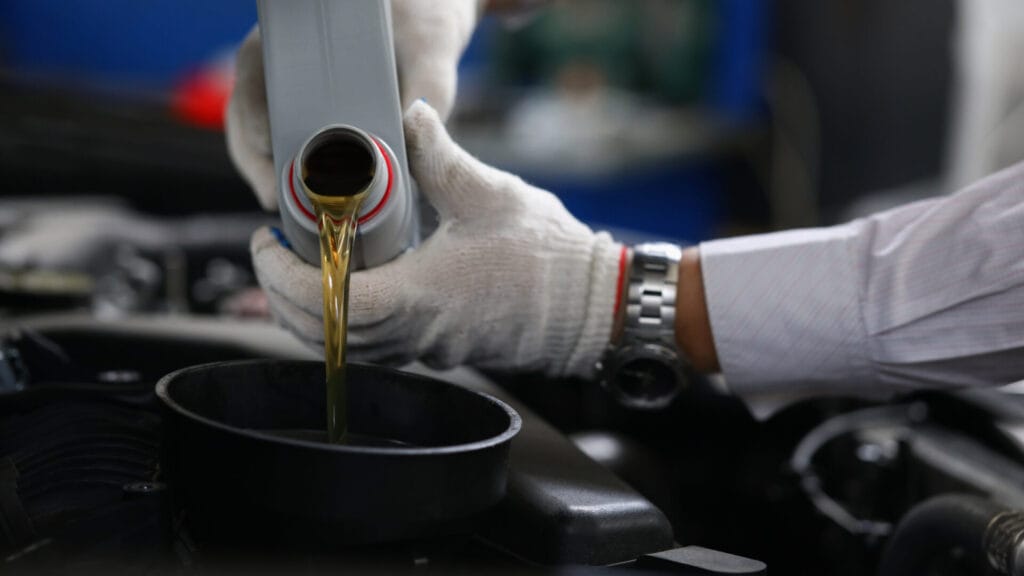Accidentally Put Transmission Fluid in Power Steering
In the hustle and bustle of vehicle maintenance, confusing the fluids is not uncommon. The bottles may look similar, the tasks might overlap, and a moment of distraction, sadly you have a mix-up at the garage, and you find yourself facing a common yet potentially troublesome mistake, accidentally putting transmission fluid in the power steering. It’s a scenario that can leave even the most seasoned car owners scratching their heads. Because we know you shouldn’t put transmission fluid in your power steering, however, sadly you have just done it. What now?

Don’t panic, mistakes are part of the journey, especially for new car owners. What defines a car enthusiast is not the absence of errors but the ability to learn and rectify them.
In the following sections, we’ll unravel the intricacies of this error so you can easily understand the gravity of the situation and guide you through the steps to rectify it.
What is Transmission Fluid & Power Steering Fluid
In the automotive orchestra, both transmission and power steering fluids play unique instruments. Imagine transmission fluid as the conductor, orchestrating the harmony of gears, while power steering fluid takes on the role of the supporting maestro, ensuring your every turn is a graceful maneuver.
Transmission Fluid’s Role:
- Enables smooth gear changes.
- Provides cooling and lubrication to transmission components.
- Guards against wear and tear in the transmission system.
Power Steering Fluid’s Role:
- Transmits hydraulic power, making steering effortless.
- Aids in responsive and precise control of the steering wheel.
- Works in a closed system, maintaining a constant flow for consistent performance.
Consequence Of Transmission Fluid in Power Steering
As both the transmission and power steering fluids are designed with different purposes, though both are hydraulic fluids, consequences can be dangerous.
Let’s know what happens when transmission fluid mistakenly finds its way into the power steering system.

Lubrication Mismatch:
Power steering systems require specific additives for optimal lubrication. Transmission fluid, while adept at its job, lacks these additives, potentially leading to increased friction and wear.
Seal and Hose Vulnerability:
The composition of power steering fluid accommodates the seals and hoses within the system. Introducing transmission fluid may compromise these components, leading to leaks and potential system failure.
Impaired Hydraulic Function:
Transmission fluid may not provide the same level of hydraulic power transmission, affecting the responsiveness and ease of steering. This could manifest as increased resistance and jerky movements.
Fluid Contamination:
Transmission fluid and power steering fluid have different chemical compositions. Mixing them can result in fluid contamination, potentially affecting the overall effectiveness of the power steering system.
Overheating:
Transmission fluid is designed to operate in a different temperature range compared to power steering fluid. The mismatched fluid may not provide adequate heat dissipation in the power steering system, leading to overheating and potential damage.
Foaming:
Transmission fluid may be more prone to foaming when used in the power steering system. Foaming can introduce air bubbles into the fluid, affecting its hydraulic properties and leading to decreased performance.
Difficulty Steering:
One of the immediate consequences is difficulty in steering. The power steering system may become less responsive when you brake pedal, making it harder to turn the steering wheel, especially at lower speeds.
System Failure:
Prolonged use of the wrong fluid can lead to severe damage to power steering components, potentially resulting in system failure. This could necessitate costly repairs or even replacement of the power steering system.
Understanding these consequences underscores the importance of using the right fluid for each automotive system. But worry not – in the next section, we’ll guide you through the process of identifying and rectifying this common mix-up.
Accidentally Put Transmission Fluid in Power Steering- What To Do Next?
Time is of the essence when you’ve accidentally introduced transmission fluid into your power steering system. Swift action can mitigate potential damage and salvage the health of your power steering components. The longer the mismatched fluid circulates, the higher the risk of complications. So, buckle up, let’s get to work promptly!

Signs and Symptoms Transmission Fluid is in Power Steering
First, you have to be double-sure you have put transmission fluid in power steering. Sometimes we mismatch bottles for not labelling, and forget which one we used or in the middle of the road you can get confused about whether you had put transmission fluid in your power steering. So how to find out about using the wrong fluid? Well, some signs are there that can help you understand what you have put in your power steering. Let’s know them.
- A visual inspection of the fluid’s color can be a quick indicator of any mismatch. Transmission fluid is typically red or pink, differentiating it from the correct power steering fluid.
- Pay attention to any changes in steering performance. If your steering wheel suddenly becomes harder to turn, it’s a red flag. Transmission fluid lacks the specific properties required for power steering, leading to increased resistance and diminished ease of steering.
- Listen for abnormal sounds when turning the steering wheel. A whining or groaning noise, particularly at low speeds, could signal a lubrication mismatch, indicating the presence of transmission fluid
- Inspect the area around the power steering pump, master cylinder, reservoir, and hoses for any signs of fluid leakage. Transmission fluid may cause damage to seals and hoses, resulting in leaks that compromise the system’s integrity.
- Unusual smells, such as a burnt odor, may also indicate transmission fluid contamination.
If you suspect transmission fluid in the power steering system, it is advisable to seek professional advice or refer to your vehicle’s manual for further guidance.
Step-by-Step Guide to Drain Transmission Fluid
If you have added transmission fluid to the power steering system, it is important to drain and refill the system correctly to ensure you bid farewell to any lingering transmission fluid and rectify the mistake. Here is a step-by-step guide to draining and refilling power steering fluid:

Necessary Tools and Materials:
- Jack and jack stands that correspond with your vehicle for safety.
- Vacuum pump
- Appropriate power steering fluid is recommended by your vehicle manufacturer.
- A catch pan for the old fluid.
- Wrench or pliers for loosening components.
Prepare the Vehicle:
Safely support the vehicle using jack stands or a lift. Position a drain pan under the two hoses connected to the power steering cooler tube. For more working room, you can remove the front wheels. Lock the push pins securing the frame rail splash shield of the core support. Then, find the power steering cooler tube and hoses. Clean the area if necessary.
Loosen and Slide Back Hoses:
Loosen the clamp securing the lower hose to the cooler tube and slide it back (low-pressure return hose). Next, secure the upper hose to the cooler tube and slide it back ( hose going to the bottom of the power steering pump). Now let the fluid run out. When fluid slows to a drip, use a suitable tool to plug the hose connected to the bottom of the power steering pump. This helps contain the fluid.
Flush the Power Steering Cooler:
Use an air compressor on a low PSI setting and a towel to prevent fluid from spraying. Ensure the low-pressure hose from the steering rack is over the drain pan. Remove the cap from the power steering pump reservoir.
Fill Reservoir and Rotate the Pump:
Fill the reservoir with fresh fluid, try to use high-quality fluid such as Dexron iii and it’s better to source it from official vendors to ensure quality. Rotate the belt tensioner to relieve tension and rotate the pump by hand to move fresh fluid through the system. Refill the reservoir when it runs low. Rotate the steering wheel back and forth several times.
Repeat Until Clean:
Repeat the process until the fluid coming out of the low-pressure hose is clean. It won’t take much fluid to accomplish this.
Reinstall Hoses and Bleed the System:
Reinstall Hoses:
- Remove the cap from the cooler tube.
- Reinstall the hose.
- Remove the plug from the other hose, letting any remaining fluid run out.
- Insert the push pin back into the core support.
- Reinstall the serpentine belt.
- Refill the reservoir with fresh fluid.
Secure Hoses:
- Position each clamp and tighten them down.
- Visually inspect the area and wipe up any residual fluid
Bleed the System:
- Have a friend watch the reservoir and tell you when to turn the car off.
- Start the car, and slowly turn the steering wheel from lock to lock to further bleed the rack and pinion.
- Pour a little more fluid into the reservoir and repeat until the fluid remains at a constant level. Reinstall the cap and double-check your work.
- If aeration is seen in the reservoir, turn the car off and let it sit until bubbles dissipate.
By following these steps to oil change diligently, your power steering system is now properly flushed and refilled. You’re good to go!
Remember, mistakes happen, but with the right guidance, you can navigate your way back to smooth driving.
Could this Mistake Totally Ruin Your Vehicle?
Yes, accidentally adding transmission fluid to the power steering reservoir could potentially ruin your vehicle if not addressed promptly. The power steering system relies on power steering fluid to function properly, and using the wrong fluid, such as transmission fluid, engine oil or motor oil, can cause significant damage. Mixing these fluids can lead to system leaks, malfunctions, and breakdowns, affecting steering control and compromising your safety on the road. Neglecting the issue or continuously using the wrong fluid can result in accelerated wear on system components, including seals, pumps, and valves. This can lead to costly repairs, reduced system performance, and even total failure of the power steering system. To prevent severe damage to your vehicle, it is crucial to address the mistake immediately and follow the necessary steps to rectify it.
Frequently Asked Question
What happens if you accidentally put coolant in the power steering fluid?
Accidentally adding coolant to the power steering fluid can lead to serious issues. Coolant is not designed for the hydraulic functions of the power steering system. This mismatch can result in poor lubrication, potential damage to seals and hoses, and compromised steering performance. Coolant may also cause overheating and foaming, leading to long-term damage.
What happens if you accidentally put power steering fluid in the brake fluid?
Brake fluid is specifically designed to withstand high temperatures and maintain braking functionality, while power steering fluid is not formulated for the high-temperature demands of brake systems. This mix-up in brake fluid reservoir can result in reduced brake performance, compromised braking efficiency, and potential damage to brake components. In that case, flushing the brake system thoroughly and refilling it with new fluid is essential to ensure optimal brake function and maintain safety on the road. If you can’t do it, take your car to an auto repair shop.
What happens if you put the wrong fluid in a power steering pump?
Different fluids serve distinct purposes, so, putting the wrong fluid in a power steering pump can lead to significant issues. This mismatch can cause reduce friction modifier, inadequate lubrication, potential damage to seals and hoses, and compromised steering performance. It may also result in increased friction, overheating, and system failure.
Will transmission fluid hurt a power steering pump?
Yes, using trans fluid in a power steering pump can potentially harm the pump. Transmission fluid is not designed for the specific hydraulic requirements of power steering systems. The mismatch can lead to poor lubrication, increased friction, and potential damage to rubber parts, seals and hoses in the ps pump. Over time, this may result in compromised pump performance, overheating, and even system failure.
Is power steering fluid thicker than transmission fluid?
Yes, typically, power steering fluid is thicker than atf fluid. Power steering fluid is formulated to provide proper lubrication and hydraulic assistance in the power steering system. It often has a higher viscosity than transmission fluid to ensure smooth power transmission and responsive steering.
Automatic Transmission fluid, on the other hand, is designed to lubricate and cool the transmission components, and it tends to have a slightly thinner consistency compared to ps fluid.
Closing Words
In conclusion, if you’ve accidentally added transmission fluid to your power steering, don’t worry. Swift action is key. By flushing the system and refilling it with the correct fluid, you can rectify the situation and keep your vehicle running smoothly. Your commitment to proper DIY maintenance goes a long way in preventing future mix-ups and ensuring a trouble-free drive.






